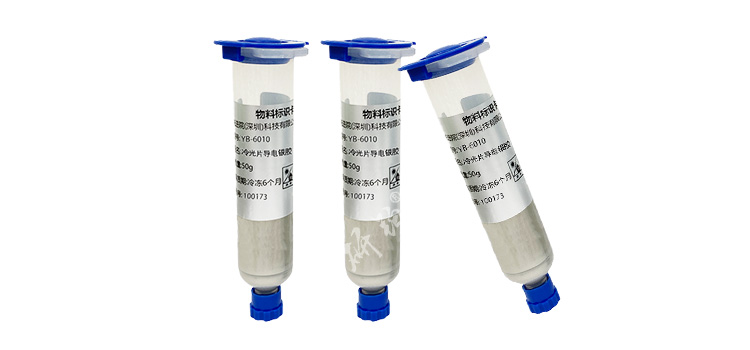

Hotline:0755-22277778
Tel:0755-22277778
Mobile:13826586185(Mr.Duan)
Fax:0755-22277776
E-mail:duanlian@xianjinyuan.cn
1. Moisture isConductive adhesiveThe impact
The water in conductive adhesive may undergo two effects: plasticization and swelling. The plasticizing effect of water can reduce the glass transition temperature, strength, and modulus of adhesives of polymers; The swelling effect of water can generate swelling stress and even irreversible physical and chemical changes. Water can erode the interface between the adhesive and the substrate, thereby reducing the strength of the joint.
2. The Effect of High Temperature on Adhesive Strength
The impact of high temperature on adhesive strength is significant: ifConductive adhesiveThe melting point of thermoplastic adhesives is relatively low, such as some thermoplastic adhesives, which have excellent performance at room temperature. However, as the temperature increases and approaches the glass transition temperature, plastic flow can cause deformation of the joint and a decrease in strength. If it is some thermosetting materials that do not soften and flow at high temperatures, their key problem is the decrease in strength caused by thermal oxidation and high-temperature decomposition. Low temperature also has an impact on adhesive strength: there is stress inside conductive adhesive, and at room temperature, low modulus conductive adhesive can easily eliminate stress concentration through deformation, while at low temperatures, the elastic modulus increases, making it difficult for conductive adhesive to eliminate stress concentration. There is stress concentration and stress gradient inside the conductive adhesive, which may causeConductive adhesiveDue to excessive stress, the adhesive joint undergoes expansion and contraction changes, resulting in the failure of the adhesive joint.

3. The Effect of Electrochemical Corrosion on Contact Resistance
Scholars have found that electrochemical corrosion is the dominant factor causing unstable contact resistance. Electrochemical corrosion usually requires the following conditions: (1) the presence of water and electrolyte; (2) Metal contacts with different electrochemical potentials; (3) One of the two metals should have an electrochemical potential below 0.4V.
So in order to suppress electrochemical corrosion, we should choose the following measures:
(1) Select conductive adhesive with low water absorption
Both resin matrix and curing agent have a significant impact on the water absorption of conductive adhesive. Aliphatic epoxy resin has higher water absorption and adhesion than bisphenol F epoxy resin.
The preferred choice is bisphenol F epoxy resin; In the curing agent, due to the small number of polar functional groups in hexahydrophthalic anhydride after curing, its water absorption is also low. After high-temperature and high humidity aging, the contact resistance is also the most stable.
(2) Add organic anti-corrosion agent
Organic corrosion inhibitors can adhere to metal surfaces to form a protective film that isolates water and air from the outside world. The experimental results show that the stability of conductive adhesive under high temperature and high humidity has been greatly improved after using anti-corrosion agents.
(3) Add deoxidizer
An important element of electrochemical corrosion is oxygen, which can be removed from the water in contact with the conductive adhesive by adding some reducing agents. Adding a deoxidizer has little effect on the mechanical and adhesive properties of the conductive adhesive, but as the deoxidizer is constantly consumed, over time, the amount of deoxidizer in the conductive adhesive decreases, and its inhibitory effect on oxygen decreases. Therefore, this method only has a slowing effect. In addition, joints coated with metals such as Cu are severely corroded by water, which may be due to the oxidation of metal Cu on the surface of the substrate. Elastic fillers can better compensate for the mechanical stress generated under thermal cycling compared to hard fillers. Therefore, many researchers currently focus on using polymer composite conductive particles asConductive adhesiveConductive fillers. For copper conductive adhesive, silver plating on the copper surface can also be used to prevent oxidation. After high-temperature exposure experiments (80 ℃, 1000h), the electrical and mechanical properties are basically equivalent to silver conductive adhesive, but the contact resistance increases after 50-100 thermal cycles.

4. The impact of external force on conductive adhesive
During the assembly process of printed circuit boards, collisions and vibrations are inevitable, which requires the conductive adhesive used here to have good impact resistance. The strength of the conductive adhesive is slightly insufficient compared to existing tin lead solder. NCMS requires PLCC (plastic lead chip packaging) carriers to withstand 6 drops from a height of 1.524m, but the existingConductive adhesive materialMost of them cannot meet this requirement. The matrix adhesive is an important factor affecting the impact toughness of conductive adhesives. Epoxy resin commonly used in conductive adhesives has poor toughness, so chemical or physical toughening of the conductive adhesive matrix can achieve ideal results in improving the impact performance of conductive adhesives.

Advanced Institute (Shenzhen) Technology Co., Ltd, © two thousand and twenty-onewww.leird.cn. All rights reservedGuangdong ICP No. 2021051947-1 © two thousand and twenty-onewww.xianjinyuan.cn. All rights reservedGuangdong ICP No. 2021051947-2